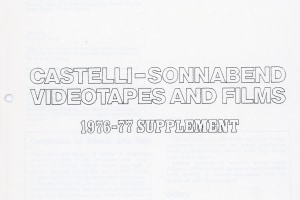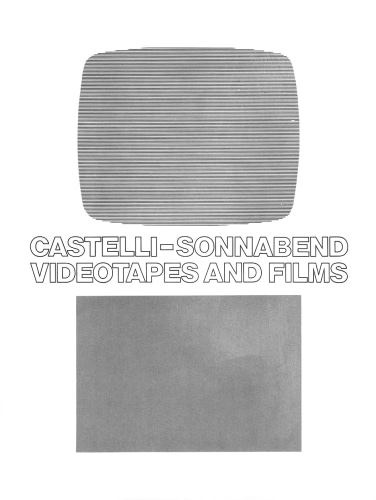

Castelli/Sonnabend Videotapes and Films (CSVAF) was a division of Leo Castelli Gallery founded in 1974 to facilitate the sale and distribution of moving-image art.[1] CSVAF was established in partnership with Ileana Sonnabend and overseen by both Nina Sundell and Joyce Nereaux. In presenting artists’ films and videos as works of art within a gallery system, CSVAF became the first organization devoted to selling moving-image art in the United States.[2] An existing model for circulating moving images augmented this pioneering approach, for much like a film distribution company, CSVAF also offered to rent artists’ works, in an effort to increase their circulation and extend their reach.
As part of this broader strategy, CSVAF produced a series of exhibitions with Leo Castelli Gallery between 1974 and 1980, which was held at 420 West Broadway. In June of 1974, a single exhibition contained work by Vito Acconci, John Baldessari, Robert Bell, Lynda Benglis, Peter Campus, Frank Gillette, Tina Girouard, Nancy Holt, Joan Jonas, Paul Kos, Richard Landry, Andy Mann, Charlemagne Palestine, Richard Serra and William Wegman. At its peak, CSVAF offered some 400 videos and films for sale or rent and represented upwards of 35 artists.[3]
CSVAF also published Castelli/Sonnabend Videotapes and Films, a series of three catalogues that provided written descriptions, film and video stills, as well as prices for the works on offer. The texts err on the side of straight description, though they occasionally slip into a more poetic voice, or contain bits of an artist statement published elsewhere in full. Vito Acconci’s Centers (1971), is described as a work in which, “the camera frames Acconci’s head and arm as he points at his own image on the video monitor,” while the text for Lynda Benglis’ Collage (1973) notes that “[. . .] hands flutter quickly across the screen, flickering and shadowy, exploring the frame of the monitor and the frames of the monitors inside the monitors.” Often sections of audio are transcribed. The text for Richard Serra’s Boomerang (1974) records Nancy Holt saying, “It puts a distance between the words and their apprehension—their comprehension . . . Words don’t seem to have the same forcefulness as when I speak them . . .” She makes these statements as she responds to the effect of the headset she wears in the video, which allowed her to hear her voice as she spoke as well as with a delay.
Castelli/Sonnabend Videotapes and Films was first published in November of 1974, with two additional supplements issued in 1975 and 1977. Each volume included a page that listed the titles and prices of available work. In the final 1977 installment, two columns separate the works into “Videotapes” and “Films.” Simone Forti’s video Crawling is listed to rent for $40 or purchase for $250, while Yvonne Rainer’s film, Kristina Taking Pictures cost $200 to rent or $1500 to buy. Worth noting, is the lack of an edition number on this list (the number that appears next to each title is the page of the work’s description). CSVAF ventured to sell unlimited-edition films and videotapes as works of art, hence the omission. Though the contradiction may seem obvious now—selling as a work of art an object that was celebrated for the ease with which it could be produced and infinitely reproduced, rather than something which is privileged for its scarcity—this effort quite radically positioned film and video art as saleable goods.
Though the number of times an individual work could be rented or sold remained unrestricted, the terms that governed these transactions were carefully described. The 1976–77 supplement includes the section, “Conditions of Rental and Sale,” which appears on its inner cover and is worth reproducing at length. It states,
Purchasers and renters of copies of videotapes and films listed in this catalogue (the “work”) acquire a limited license under copyright to exhibit the work during the term of their license, subject to the following terms and conditions:
The work may not be copied or duplicated; it may not be rented or loaned to others or exhibited away from the purchaser’s or renter’s premises or utilized commercially in any way; it may not be broadcast or transmitted by cable or otherwise and admission fees may not be charged to view it.
If purchased works become worn or damaged, new copies may be secured by returning the work to Castelli-Sonnabend and paying the charges for new copies then in effect. These charges are based upon actual reproduction, shipping and other costs attributable to this service.
All copyrights and reproduction rights in videotapes and films listed in this catalogue remain the sole property of the artist.
The first two paragraphs make clear that renters and purchasers, despite being in possession of an artist’s work, ought not to copy or in any way profit from it. The need for such an agreement acknowledges the ease with which one might disseminate or even reproduce it and reveals the tension inherent in relying on technologies of recording and reproduction as carriers of works of art. The third paragraph deals explicitly with the material reality of engaging with videotapes and film. Despite the fact that many an artist began working with video to shatter the privileged status of the object in art, what Lucy Lippard described as the “deemphasis (sic) on material aspects (uniqueness, permanence, decorative attractiveness)” of this new work, the means through which an audience accessed it was bound by very material concerns. Videotapes and film are subject to the wear and tear that comes with use. That either would be replaced at cost should they become damaged, instantiates a divide between content and carrier that remains the contemporary view of most moving-image art.
CSVAF made videotapes available on half-inch reel-to-reel or three-quarter inch videocassette, and with few exceptions, all films were offered in 16 mm. Orders for videotapes and films could be placed through the director of CSVAF, which by 1977 was located at 420 West Broadway. Unfortunately, rentals remained more popular than purchasing the works themselves, and although CSVAF introduced artists’ films and videos as something to be bought and sold, it was not financially solvent in its day.[4] CSVAF closed on July 1, 1985, though Castelli Gallery continued to showcase works by artists in both video and film.
- Castelli Gallery
[1] Moving-image art is a contemporary and therefore somewhat anachronistic term to apply here, yet it describes an expanded field of film and video production that traces its origins to the late 1960s and encompasses performance, body art, experimental film, installation, and site-specific art from this period to the present day. For its application in more contemporary art practices see: Omar Kholeif, Moving Image, (Cambridge, MA: The MIT Press, 2015).
[2] Erika Balsom, “Original Copies: How Film and Video Became Art Objects,” Cinema Journal 53, no. 1 (2013): 106.
[3] Kim Dixon and Sarah Huag, “Series 8: Castelli/Sonnabend Tapes and Films, 1969 – 1998,” Leo Castelli Gallery Records, circa 1880 – 2000, bulk 1957 – 1999, Archives of American Art, May 14, 2010, https://www.aaa.si.edu/collections/leo-castelli-gallery-records-7351/series-8.
[4] Balsom, “Original Copies: 107.